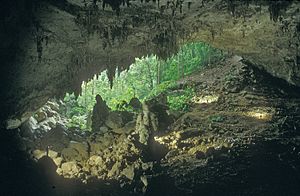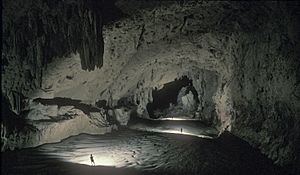Chiquibul Cave System facts for kids
The Chiquibul Cave System is a huge and famous group of caves in Central America. It's made up of four main caves: Actun Kabal, Actun Tun Kul, and Cebada Cave in Belize, and Xibalba in Guatemala. There are also many smaller caves connected to them. This amazing system has two of the biggest cave rooms (called caverns) on Earth!
Contents
Actun Kabal: A Giant Cave
Actun Kabal is the upper part of the Chiquibul Cave System. Explorers have mapped over 12 kilometers (about 7.5 miles) of its passages. It goes down about 95 meters (312 feet) deep. Inside, you'll find the Chiquibul Chamber, which is one of the world's largest cave rooms. It's about 250 meters (820 feet) long and 150 meters (492 feet) wide!
Actun Tun Kul: The Stone Drum Cave
Actun Tun Kul means "stone drum." This cave holds the Belize Chamber, another one of the largest natural cave rooms in the world. It measures about 300 meters (984 feet) long, 150 meters (492 feet) wide, and 65 meters (213 feet) high! In 1999, explorers connected Actun Tun Kul with Cebada Cave. This made a super-long cave system that is about 39 kilometers (24 miles) long.
Cebada Cave: Belize's Longest Cave
Cebada Cave became connected to Actun Tun Kul in 1999. At 39 kilometers (24 miles) long, it is now the longest cave in all of Belize!
Xibalba: The Underworld Cave
Xibalba is the part of the Chiquibul Cave System that is completely inside Guatemala. It goes down about 187 meters (614 feet) deep. For a short time, it was the deepest cave in Guatemala. Today, another cave called Jul Mas Nim is deeper, at 294 meters (965 feet). Explorers have mapped over seven kilometers (about 4.3 miles) of passages in Xibalba. Some of these passages are more than 100 meters (328 feet) wide! The entrance to the cave itself is about 200 meters (656 feet) across.
Exploring the Chiquibul Caves
People have been exploring the Chiquibul Cave System for many years.
- In 1971 and 1982, cavers (cave explorers) Mike Boon and Tom Miller visited the area.
- Tom Miller started the first real cave explorations as part of his studies.
- From 1984 to 1988, Miller led big expeditions with people from different countries and fields of study. These trips even got some money from famous groups like National Geographic and the National Speleological Society.
- The first expedition mapped 23 kilometers (14 miles) of dry passages in Kabal and Tun Kul.
- The second expedition mapped 27 kilometers (17 miles) of dry and river passages in Cebada and Xibalba.
- In 1990, Steve Grundy and Olivia Whitwell created a full cave survey map of the system.
Cave Life: Biology
Scientists have studied the animals living in the Chiquibul Cave System. In 1986, they collected and observed many creatures in Cebada Cave. Other collections were made in 1984 and 1988. So far, they know of 70 different kinds of invertebrates (animals without backbones, like insects or spiders) that live in this amazing cave system.
Protecting the Caves
Even though the Chiquibul Cave System is far away from cities, it faces some dangers. People sometimes do things that harm the area, such as:
- Clearing land for farming
- Starting fires
- Illegal logging (cutting down trees illegally)
- Hunting wild animals
- Stealing old cultural items
- Damaging both ancient artifacts and natural cave features
The Chiquibul Cave System is located inside Chiquibul National Park. This park is a huge protected area of about 264,000 acres in the Maya Mountains. In 2007, people realized that the cave system needed special care. So, in 2010, a group called The Nature Conservancy made a five-year plan to manage the area. This plan includes allowing a very small number of tourists to visit, but only in a controlled way to keep the caves safe.
See also
 In Spanish: Sistema de cuevas Chiquibul para niños
In Spanish: Sistema de cuevas Chiquibul para niños



